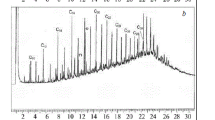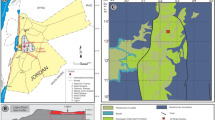Abstract
A series of seven Alum Shale samples has been analyzed by pyrolytic, petrologic, and spectroscopic methods. All contain alginitic kerogens at various levels of alteration. Kerogens from four samples appear immature to early mature, whereas three samples are more mature, especially one which is very overmature. Decreasing pyrolysate yields per unit weight of carbon characterize the series. Alum Shale alginite is unlike any other alginite we have studied. Aliphatic carbon is present in all but the highly overmature kerogen, yet only a small proportion of aliphatic moieties is released during high-temperature pyrolysis. Furthermore, all the pyrolysates are very aromatic. The unusual structure of Alum Shale alginite might have been brought about by uranium-related alteration effects. Alternatively, or additionally, its structure might have been directly inherited from biopolymeric or carotenoid-derived precursors in algae and bacteria. Mainly gas and condensate are evolved from Alum Shale kerogen during simulated maturation, and a high proportion (more than 30%) of its originally labile components are progressively and cumulatively converted to “dead carbon”. Available data indicate that the Alum Shale behaves similarly during natural maturation.
Access this chapter
Tax calculation will be finalised at checkout
Purchases are for personal use only
Preview
Unable to display preview. Download preview PDF.
Similar content being viewed by others
References
Bertrand P, Pittion J-L, Bernard C (1986) Fluorescence of sedimentary organic matter in relation to its chemical composition. Org Geochem 10: 641–647
Bharati S (1989) Physical and chemical evolution of source rocks and source rock kerogens of algal origin. Cand Sci Thesis, Univ Oslo
Buchardt B, Clausen J, Thomsen E (1986) Carbon isotopic composition of Lower Palaeozoic kerogen: effects of maturation. Org Geochem 10: 127–134
Chalansonnet S, Largeau C, Casadevall E, Berkaloff C, Peniguel G, Couderc R (1988) Cyanobacterial resistant biopolymers. Geochemical implications of the properties of Schizothrix sp. resistant material. In: Mattavelli L, Novelli L (eds) Advances in organic geochemistry, 1987. Pergamon, Oxford, pp 1003–1010
Cooles GP, Mackenzie AS, Quigley TM (1986) Calculation of petroleum masses generated and expelled from source rocks. Org Geochem 10: 235–245
Dahl J, Hallberg R, Kaplan IR (1988) The effects of radioactive decay of uranium on elemental and isotopic ratios of Alum Shale kerogen. Appl Geochem 3: 583–589
Espitalié J, Laporte JL, Madec M, Marquis F, Leplat P, Paulet J, Boutefeu A (1977) Méthode rapide de charactérisation des roches mères de leur potential pétrolier et de leur degré d’évolution. Rev Inst Fr Petrole 32:23–42
Espitalié J, Madec M, Tissot B (1980) role of mineral matrix in kerogen pyrolysis: influences on petroleum generation and migration. Bull Am Assoc Petrol Geol 64: 59–66
Espitalié J, Marquis F, Barsony I (1984) Geochemical logging. In: Voorhees KJ (ed) Analytical pyrolysis techniques and applications. Butterworths, London, pp 276–304
Horsfield B (1989) Practical criteria for classifying kerogens: some observations from pyrolysis-gas chromatography. Geochim Cosmochim Acta 53:891–901
Horsfield B, Dembicki H, Ho TTY (1983) Some potential applications of pyrolysis to basin studies. J Geol Soc London 140:431–443
Horsfield B, Disko U, Leistner F (1989) The microscale simulation of maturation: outline of a new technique and its potential applications. Geol Rundsch 78: 361–374
Larter SR (1978) A geochemical study of kerogens and related materials. Ph D Thesis, Univ Newcastle/Upon Tyne
Larter SR (1984) Application of analytical pyrolysis techniques to kerogen characterization and fossil fuel exploration/exploitation. In: Voorhees KJ (ed) Analytical pyrolysis techniques and applications. Butterworths, London, pp 212–275
Larter SR (1985) Integrated kerogen typing and the quantitative evaluation of petroleum source rocks. In: Thomas BM et al. (eds) Petroleum geochemistry in exploration of the Norwegian Shelf. Graham & Trotman, London, pp 269–286
Larter SR, Horsfield B (1991) Determination of structural components of kerogen using analytical pyrolysis methods. In: Engel M. Macko S (eds) Organic geochemistry. Plenum. New York (in press)
Leventhal JS. Daws TA, Frye JS (1986) Organic geochemical analysis of sedimentary organic matter associated with uranium. Appl Geochem 1:241–247
Lewan M, Buchardt B (1989) Irradiation of organic matter by uranium decay in the Alum Shale, Sweden. Geochim Cosmochim Acta 53: 1307–1322
Lin R, Davis A (1988) A fluorogeochemical model for coal macerals. Org Geochem 12: 363–374
Littke R, Baker DR, Leythaeuser D (1988) Microscopic and sedimentologic evidence for the generation and migration of hydrocarbons in Toarcian source rocks of different maturities. In: Mattavelli L, Novelli L (eds) Advances in organic geochemistry 1987. Pergamon, Oxford, pp 549–559
MetzgerP, Berkaloff C, Casadevall E, Coute A (1985) Alkadiene and botryococcene-producing races of mild strains of Botryococcus braunii. Phytochemistry 24:2305–2312
Reed J, Illich HA, Horsfield B (1986) Biochemical Evolutionary significance of Ordovician oils and their source. In: Leythaeuser D, Rullkötter J (eds) Advances in organic geochemistry 1985. Pergamon, Oxford, pp 347–358
Schaefer RG, Littke R (1988) Maturity-related compositional changes in the low-molecular-weight hydrocarbon fraction of Toarcian shales. In: Mattavelli L. Novelli L (eds) Pergamon, Oxford, pp 887–892
Schenk H-J, Witte EG, Müller PJ, Schwochau K (1986) Infrared estimates of aliphatic kerogen carbon in sedimentary rocks. Org Geochem 10: 1099–1104
Sinninghe Damsté JS, Kock-van Dalen AC, de Leeuw JW (1988) Identification of long-chain isoprenoid alkylbenzenes in sediments and crude oils. Geochim Cosmochim Acta 52:2671–2677
Summons RE, Powell TG (1987) Identification of aryl isoprenoids in source rocks and crude oils: biological markers for the green sulphur bacteria. Geochim Cosmochim Acta 51:557–566
Teichmüller M, Durand B (1983) Fluorescence microscopical rank studies on liptinites and vitrinites in peat and coals, and comparison with results of the Rock-Eval pyrolysis. Int J Coal Geol 2: 197–230
van Graas G, de Leeuw JW, Schenck PA, Haverkamp J (1981) Kerogen of Toarcian shales of the Paris Basin. A study of its maturation by flash pyrolysis techniques. Geochim Cosmochim Acta 45: 2465–2474
Author information
Authors and Affiliations
Editor information
Editors and Affiliations
Rights and permissions
Copyright information
© 1992 Springer-Verlag Berlin Heidelberg
About this chapter
Cite this chapter
Horsfield, B. et al. (1992). On the Atypical Petroleum-Generating Characteristics of Alginite in the Cambrian Alum Shale. In: Schidlowski, M., Golubic, S., Kimberley, M.M., McKirdy, D.M., Trudinger, P.A. (eds) Early Organic Evolution. Springer, Berlin, Heidelberg. https://doi.org/10.1007/978-3-642-76884-2_19
Download citation
DOI: https://doi.org/10.1007/978-3-642-76884-2_19
Publisher Name: Springer, Berlin, Heidelberg
Print ISBN: 978-3-642-76886-6
Online ISBN: 978-3-642-76884-2
eBook Packages: Springer Book Archive




